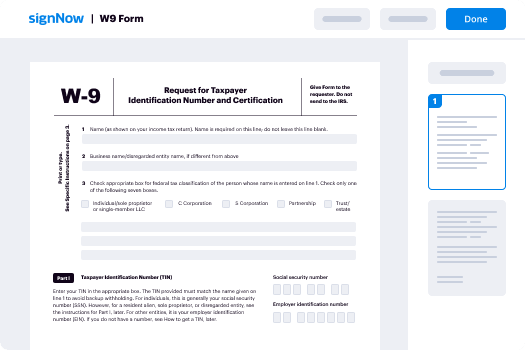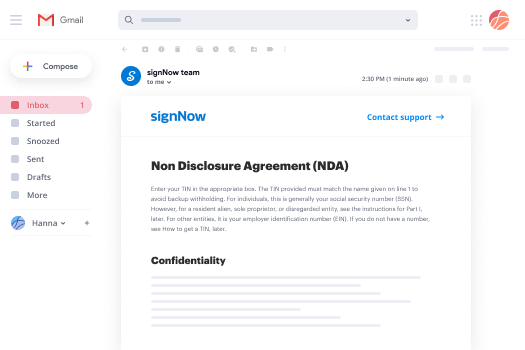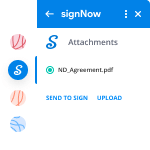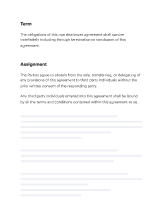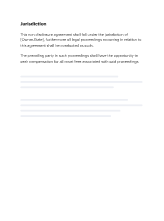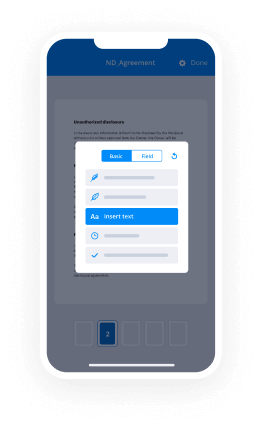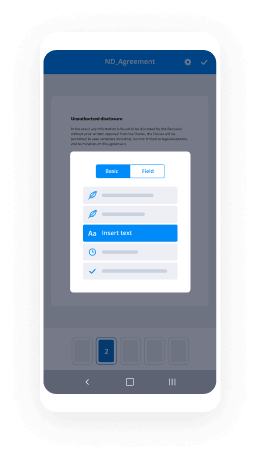Explorez Votre Signature Numérique – Questions Répondues : Signature Numérique Contre Signature électronique
- Démarrage rapide
- Facile à utiliser
- Support 24/7
Les entreprises qui pensent à l'avance dans le monde entier font confiance à airSlate pour le moment






Guide de démarrage rapide sur l'utilisation de la signature numérique par rapport à la fonctionnalité de signature électronique
Votre organisation est-elle prête à réduire les inefficacités d'environ trois quarts ou plus ? Avec airSlate SignNow eSignature, des semaines d'approbation de contrat deviennent des jours, et des heures de collecte de signatures deviennent des minutes. Vous n'aurez pas besoin d'apprendre tout depuis le début grâce à l'interface claire et aux guides étape par étape.
Suivez les étapes ci-dessous pour utiliser la fonctionnalité de signature numérique par rapport à la signature électronique en quelques minutes :
- Lancez votre navigateur et accédez à signnow.com.
- Inscrivez-vous pour un essai gratuit ou connectez-vous avec votre e-mail ou vos identifiants Google/Facebook.
- Cliquez sur Avatar de l'utilisateur -> Mon compte dans le coin supérieur droit de la page.
- Personnalisez votre Profil utilisateur en ajoutant des informations personnelles et en ajustant les configurations.
- Créez et gérez votre (vos) Signature(s) par défaut.
- Retournez à la page du tableau de bord.
- Survolez le bouton Télécharger et créer et choisissez l'option appropriée.
- Cliquez sur la touche Préparer et envoyer à côté du titre du document.
- Entrez le nom et l'adresse e-mail de tous les signataires dans la fenêtre contextuelle qui s'ouvre.
- Utilisez le menu Commencer à ajouter des champs pour commencer à modifier le fichier et à le signer vous-même.
- Cliquez sur ENREGISTRER ET INVITER une fois terminé.
- Continuez à peaufiner votre flux de travail eSignature en utilisant des fonctionnalités supplémentaires.
Il n'a jamais été aussi simple d'utiliser la fonctionnalité de signature numérique par rapport à la signature électronique. Elle est également accessible sur vos téléphones mobiles. Installez l'application airSlate SignNow pour iOS ou Android et exécutez vos flux de travail eSignature personnalisés même en déplacement. Évitez l'impression et la numérisation, le classement chronophage et l'expédition de documents coûteuse.
Comment ça marche
Évaluez votre expérience
What is the digital signature versus electronic signature
A digital signature is a specific type of electronic signature that uses cryptographic techniques to provide a higher level of security and authenticity. It ensures that the signer is who they claim to be and that the document has not been altered after signing. In contrast, an electronic signature encompasses a broader range of methods for signing documents electronically, including scanned images of handwritten signatures, typed names, or even a simple click to agree. Understanding the distinction is crucial for businesses navigating legal and compliance requirements in the United States.
How to use the digital signature versus electronic signature
Using a digital signature involves a few steps that ensure both security and compliance. First, the signer must obtain a digital certificate from a trusted certificate authority. This certificate is then used to create the digital signature, which is applied to the document. For electronic signatures, users can utilize platforms like airSlate SignNow to upload their documents, add their signature using various methods (such as drawing, typing, or uploading an image), and send them for signature. Both methods streamline the signing process, but digital signatures offer enhanced security features.
Legal use of the digital signature versus electronic signature
In the United States, both digital and electronic signatures are legally recognized under the Electronic Signatures in Global and National Commerce (ESIGN) Act and the Uniform Electronic Transactions Act (UETA). Digital signatures are often required for transactions that demand a higher level of security, such as financial agreements or legal contracts. Electronic signatures, while also valid, may be more suitable for less formal documents. It is essential for businesses to understand the legal implications of each type to ensure compliance with relevant regulations.
Security & Compliance Guidelines
When utilizing digital and electronic signatures, businesses must adhere to specific security and compliance guidelines to protect sensitive information. Digital signatures require robust encryption methods to ensure the authenticity of the signer and the integrity of the document. Electronic signature platforms like airSlate SignNow implement security measures such as audit trails, secure storage, and user authentication to safeguard documents. Regularly reviewing compliance with industry standards and regulations is vital to maintaining trust and security in electronic transactions.
Steps to complete the digital signature versus electronic signature
Completing a digital signature involves several steps: obtaining a digital certificate, creating the signature using cryptographic software, and applying it to the document. For electronic signatures, the process is typically more straightforward: users can upload their document to airSlate SignNow, select the area for their signature, and choose their preferred signing method. After signing, the document can be sent to other parties for their signatures or securely stored for future reference. Both processes facilitate efficient workflows while ensuring legal validity.
Examples of using the digital signature versus electronic signature
Digital signatures are commonly used in high-stakes environments, such as signing mortgage documents, tax filings, or legal contracts where security is paramount. Electronic signatures, on the other hand, are widely used for everyday transactions like signing employment contracts, consent forms, or invoices. Understanding the context in which each type of signature is used can help businesses choose the appropriate method for their needs, ensuring both efficiency and compliance.
Sending & Signing Methods (Web / Mobile / App)
With airSlate SignNow, users can send and sign documents through various methods, including web browsers, mobile devices, and dedicated apps. The web platform allows users to upload documents directly from their computers, while mobile apps enable on-the-go signing and sending. This flexibility ensures that users can manage their documents efficiently, regardless of their location. Whether using a desktop or mobile device, airSlate SignNow provides a seamless experience for all signing needs.
Obtenez dès maintenant des signatures juridiquement contraignantes !
-
Meilleur ROI. Nos clients obtiennent un ROI 7 fois en moyenne au cours des six premiers mois.
-
Échelle avec vos cas d'utilisation. De SMB à moyen marché, airSlate SignNow fournit des résultats pour les entreprises de toutes tailles.
-
Interface utilisateur intuitive et API. Signez et envoyez des documents depuis vos applications en quelques minutes.
Signature en ligne de la FAQ
-
What is the difference between a digital signature and an electronic signature?
A digital signature is a specific type of electronic signature that uses cryptographic techniques to provide a higher level of security and authenticity. In contrast, an electronic signature can be any digital representation of a person's intent to sign a document. Understanding the difference between digital signature versus electronic signature is crucial for businesses looking to ensure compliance and security. -
How does airSlate SignNow handle digital signatures versus electronic signatures?
airSlate SignNow offers both digital signatures and electronic signatures, allowing users to choose the level of security they need. Digital signatures provide enhanced security through encryption, while electronic signatures offer a more straightforward signing process. This flexibility helps businesses meet their specific requirements when considering digital signature versus electronic signature options. -
What are the benefits of using digital signatures over electronic signatures?
Digital signatures offer superior security features, including encryption and authentication, making them ideal for sensitive documents. They also provide a clear audit trail, which is essential for compliance. When comparing digital signature versus electronic signature, businesses often find that the added security of digital signatures is worth the investment. -
Are there any pricing differences between digital signatures and electronic signatures on airSlate SignNow?
Pricing for digital signatures and electronic signatures on airSlate SignNow may vary based on the features and security levels required. Typically, digital signatures may come at a premium due to their advanced security measures. It's important to evaluate your needs when considering the pricing differences in the digital signature versus electronic signature landscape. -
Can I integrate airSlate SignNow with other applications for digital and electronic signatures?
Yes, airSlate SignNow offers integrations with various applications, allowing users to streamline their workflows for both digital and electronic signatures. This capability enhances productivity and ensures that documents can be signed seamlessly across different platforms. When exploring digital signature versus electronic signature solutions, integration options can signNowly impact your choice. -
What industries benefit most from using digital signatures versus electronic signatures?
Industries such as finance, healthcare, and legal often benefit more from digital signatures due to their enhanced security and compliance requirements. However, many businesses across various sectors can effectively use electronic signatures for everyday transactions. Understanding the specific needs of your industry can help clarify the digital signature versus electronic signature decision. -
Is it legally binding to use digital signatures versus electronic signatures?
Both digital signatures and electronic signatures are legally binding in many jurisdictions, provided they meet specific criteria. Digital signatures often have a stronger legal standing due to their security features. When considering the legal implications of digital signature versus electronic signature, it's essential to understand the regulations in your area.
Votre guide complet
Rejoignez plus de 28 millions d'utilisateurs airSlate
Obtenir plus
- Légalité de la signature électronique pour la lettre ...
- Comprendre la légalité de la signature électronique ...
- Explorer la légalité des signatures électroniques ...
- Légalité de la signature électronique pour la lettre ...
- Légalité de la signature électronique pour les ...
- Légalité de la signature électronique pour la lettre ...
- Légalité de la signature électronique pour les ...
- Légalité de la signature électronique pour les ...




















